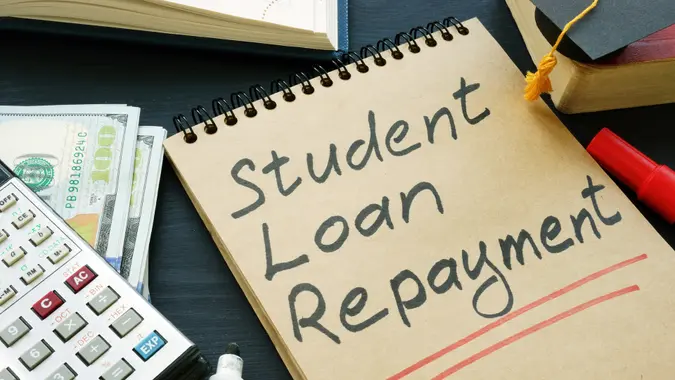Student Loans: Here’s How You Can Transfer a Parent Plus Loan Into Your Child’s Name

Commitment to Our Readers
GOBankingRates' editorial team is committed to bringing you unbiased reviews and information. We use data-driven methodologies to evaluate financial products and services - our reviews and ratings are not influenced by advertisers. You can read more about our editorial guidelines and our products and services review methodology.

20 Years
Helping You Live Richer

Reviewed
by Experts

Trusted by
Millions of Readers
Parent Plus loans — also known as a Direct PLUS Loan — are issued by the federal government and let parents of dependent students borrow funds to help pay for a student’s college or career school.
These loans are issued directly to parents and the interest rate for Parent PLUS Loans first disbursed on or after July 1, 2023, and before July 1, 2024, is currently 8.05%, according to Sallie Mae.
There are more than 3.7 million people who hold Parent Plus loans, which make up more than $107 billion of the Education Department’s student loan portfolio, according to Inside Higher Ed.
Can You Transfer a Parent PLUS Loan to Your Child?
You can — under certain conditions — and it could make sense if your child has good credit, a strong income and the willingness to take on payment responsibility, according to Experian.
For traditional undergrad students, this is an after-graduation event and students will need to have enough income, with a high enough credit score, to use a private refinance student loan to pay off a Parent PLUS loan, said Jack Wang, wealth advisor, college financial aid advisor at Innovative Advisory Group.
Wang added that not all student loan lenders will allow the student graduate to refinance a parent loan. In addition, if a student needs a parent to co-sign, that would normally negate the goal of getting the loan out of the parent’s name.
“However, some private loans offer co-signer release, which would remove the parent from being responsible for the loan upon certain criteria being met, such as a number of on-time payments made,” he added.
What Are the Advantages?
The main advantage to the parent would be no longer being legally responsible for the loan, and not showing on the parent’s credit report, according to Wang. Another advantage can be a lower interest rate than on the PLUS loan, thus potentially saving interest and lowering the monthly payment.
Jeff Rose, CFP and founder of Good Financial Cents, said this can be a good move for parents looking to lighten their financial load and for young adults ready to take on the responsibility (and maybe snag a better interest rate).
“Transferring a Parent PLUS Loan to the child can be a relief for parents. It can free up their credit, making it easier to get other loans or mortgages,” said Rose.
And for the child, it’s a step toward financial independence.
“If they have a solid credit score and a decent income, they might even land a lower interest rate, saving some cash in the long run,” he said. “It also feels pretty good for the child to take charge of their own education debt. But it’s super important that the child can manage the payments comfortably without straining their budget.”
Are There Downsides?
As Peter C. Earle, economist at American Institute for Economic Research, explained, parents who still claim the student as a dependent on their tax returns may be eligible for tax benefits related to student loan interest payments. But, they would become ineligible for them if the loan were refinanced in the student’s name.
“Doing so may result in the forfeiture of certain federal loan benefits, including forgiveness and income-based repayment plans,” said Earle. “Alternately, some families agree to a shared repayment strategy, where the student contributes to the monthly payments parents make.”
 Written by
Written by  Edited by
Edited by 
























